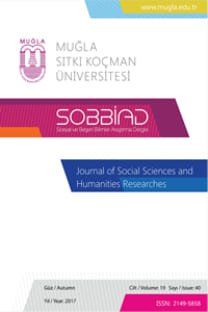SÜREÇ İYİLEŞTİRME ÇALIŞMALARINDA VERİ MADENCİLİĞİ YAKLAŞIMININ KULLANILMASI ÜZERİNE BİR ÇALIŞMA
Sürekli İyileştirme, Altı Sigma Metodolojisi, Veri Madenciliği
THE STUDY ABOUT USİNG DATA MİNİNG APPROACH İN PROCESS IMPROVEMENT FİELD
___
- Carr, D.K ve H.J Johansson.(1997). Best Practies in Reengineering, McGrawHill: New York.
- Chakrabarty, Ayon ve Kay Chuan Tan.(2007). “The Current State of Six SigmaApplication In Services”. Deparment of Industrial and Systems Engineering. National University of Singapore: Singapore, Cilt:17, ss:194-208.
- Çavuşoğlu, İlknur. (2006). “Modern Kalite Yönetim Sistemlerinin EndüstriyelUygulamalarında Proses Performanslarının Değerlendirilmesi veSürekli İyileştirilmesi” (Yayınlanmış Doktora Tezi), Yıldız Teknik Üniversitesi Fen Bilimleri Enstitüsü: İstanbul.
- Eroğlu, Cihan. (2006), ”Sürekli İyileştirme ve Bir Uygulama”, (Yayınlanmış Yüksek Lisans Tezi). Marmara Üniversitesi Sosyal Bilimler Enstitüsü: İstanbul.
- Evans, James R. ve William M. Lindsay. (2005). An Introduction to Six Sigma& Process Improvement. Thomson South-Western: Ohio.
- Giudici, Paolo. (2003). Applied Data Mining Statistical Methods for Businessand Industry. John Wiley & Sons. University of Pavia: Italy.
- Harrington, H.J.(1995). Total Improvement Management: The Next Generationin Performance Improvement. McGraw Hill: New York.
- Juran, J. ve Godfrey, B. (1999). Juran’ s Quality Handbook, Mc Graw Hill: New York
- Köksal, Gülser. (2007). 2. Uluslararası Kalite Organizasyonları ve Profesyonelleri Zirvesi. Erişim Tarihi: 12 Kasım 2007,
- http://www.kalder.org/genel/16kongre/GULSER%20KOKSAL.ppt(07. 05.2008)
- Lowenthal, J.(2002). Six Sigma Project Management: A Pocket Guide. ASQQuality Press Milwaukee: Winconsin.
- Pande P. Neuman R. veCavanagh R. (2000), The Six Sigma Way How GE,Motorola And Other Top Companies Are Honing Their Performance. McGraw Hill: New York.
- Pyzdek, Thomas. (2003), The Six Sigma Handbook. McGraw Hill: New York. Roberts, Lon. (1994). Process Reengineering: The Key to Achieving Breakthrough Success. Milwaukee ASQC Quality Pres
- ISSN: 2149-5858
- Yayın Aralığı: Yılda 2 Sayı
- Başlangıç: 2000
- Yayıncı: Mugla Sitki Kocman University
MUĞLA’DA BÜYÜKŞEHİR BELEDİYESİ YAPILANMASI SÜRECİNE İLİŞKİN BİR DEĞERLENDİRME
Ayşe YILDIZ ÖZSALMANLI, Çiğdem PANK
SÜREÇ İYİLEŞTİRME ÇALIŞMALARINDA VERİ MADENCİLİĞİ YAKLAŞIMININ KULLANILMASI ÜZERİNE BİR ÇALIŞMA
Esin Cumhur YALÇIN PİRİNÇCİLER, Ali ŞEN
BULANIK SERVQUAL YAKLAŞIMIYLA TOPLU TAŞIMADA KALİTENİN ÖLÇÜLMESİ
Ali Rıza FİRUZAN, Süleyman ALPAYKUT, Ümit KUVVETLİ
ÇOCUK EDEBİYATININ TÜRKÇE EĞİTİMİNDEKİ YERİ: BİYOGRAFİ ÖRNEĞİ
ARNOLD WESKER'S THE MERCHANT: RE-READING OF SHAKESPEARE'S THE MERCHANT OF VENICE
ANADOLU'NUN İLK KAMUSAL MEKANI:KAHVEHANE
MEHMET AKİF ERSOY’UN SPORCU KİŞİLİĞİ, SPORUN AKİF’İN KİŞİLİĞİ VE MISRALARI ÜZERİNDEKİ ETKİSİ
DERS GÜNLÜĞÜ YAZMANIN İLKOKUL 4. SINIF ÖĞRENCİLERİNİN AKADEMİK BAŞARILARINA ETKİSİ
KONAKLAMA TESİSLERİNİN PERFORMANSLARINI ETKİLEYEN FAKTÖRLERİN İNCELENMESİ : MARMARİS ÖRNEĞİ
